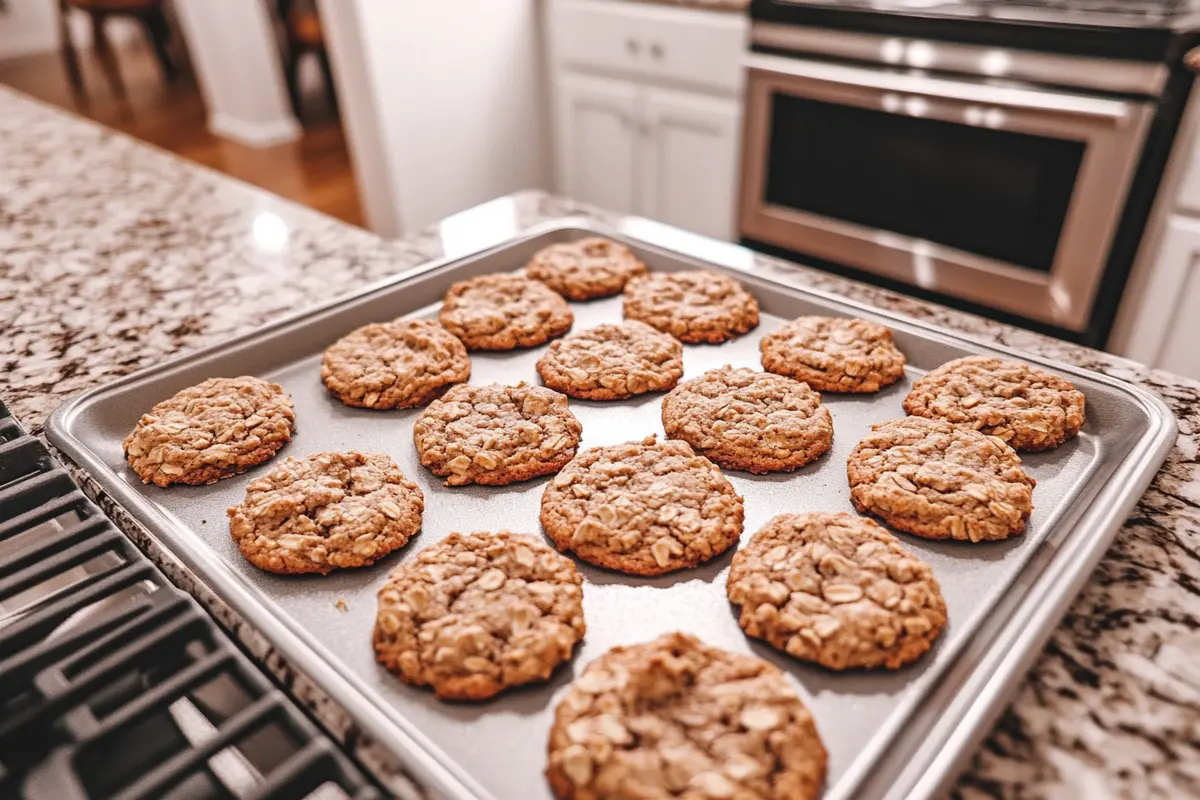Table of Contents
Introduction
No baking soda oatmeal cookies are a common baking variation, often unintentional. Many recipes call for baking soda in oatmeal cookies. But what happens when it’s left out? Is it a baking disaster, or just a different kind of cookie? Let’s explore the surprising differences you can expect.
The Indispensable Role of Baking Soda
Baking soda is often called for in cookie recipes for good reason. It’s not just a filler ingredient. It plays an indispensable role in achieving the texture and rise we expect in cookies. Understanding its function is key to understanding the impact of its absence.
Leavening Power Unveiled
Baking soda, scientifically known as sodium bicarbonate, is a chemical leavening agent. This means it produces gas, specifically carbon dioxide, which makes baked goods rise. It needs an acid to activate this gas production.
Common acidic ingredients in oatmeal cookie recipes include brown sugar, molasses, and even chocolate chips. When baking soda reacts with these acids, it creates carbon dioxide bubbles within the dough. These bubbles expand in the oven’s heat, leading to a lighter texture.
Texture Transformation Explained
Baking soda is a primary driver of cookie texture. It promotes a softer, chewier interior. The carbon dioxide gas creates a more open crumb structure. This airy interior is what gives cookies their desirable chewiness and tenderness.
Without baking soda, oatmeal cookies will lack this airy quality. They become denser and more compact. The crumb structure is tighter, resulting in a firmer, less chewy texture. This texture transformation is often the most noticeable difference.
Spread Control Dynamics
Spread, or how much cookies flatten during baking, is also influenced by baking soda. Baking soda encourages spread by relaxing the gluten in the dough and increasing its fluidity. This leads to flatter cookies with crispier edges.
No baking soda oatmeal cookies will spread less. The dough remains more viscous and less prone to flattening. The resulting cookies will be thicker and more domed. This difference in spread impacts both the appearance and the texture, leading to a different cookie experience.
Browning and Color Enhancement
Baking soda is alkaline, which affects browning. It promotes the Maillard reaction, a chemical reaction between amino acids and reducing sugars that creates brown color and complex flavors in baked goods. Golden-brown cookies are visually appealing and often more flavorful.
Cookies baked without baking soda often exhibit less browning. They may be paler and less golden. The reduced Maillard reaction means less color development and potentially less depth of flavor. Browning is a key visual and flavor cue in baking.
Flavor Profile Modification
Baking soda, even in small amounts, can subtly modify flavor. It can contribute a slight saltiness that balances sweetness. It also enhances other flavors in the recipe, creating a more well-rounded taste profile.
When baking soda is omitted, the flavor profile might seem slightly less complex. The sweetness may be more pronounced, and other flavors less integrated. While not a drastic change, discerning palates might detect a subtle lack of flavor depth and balance.
pH Level Alteration
Baking soda raises the pH level of cookie dough, making it more alkaline. This altered pH influences gluten development, protein coagulation, and starch gelatinization during baking. These factors collectively contribute to the final cookie characteristics.
Without baking soda, the pH of the dough remains lower, closer to neutral or slightly acidic. This different pH environment changes the baking chemistry at a molecular level. The pH alteration is a fundamental factor underpinning the observable differences in texture, spread, and browning.
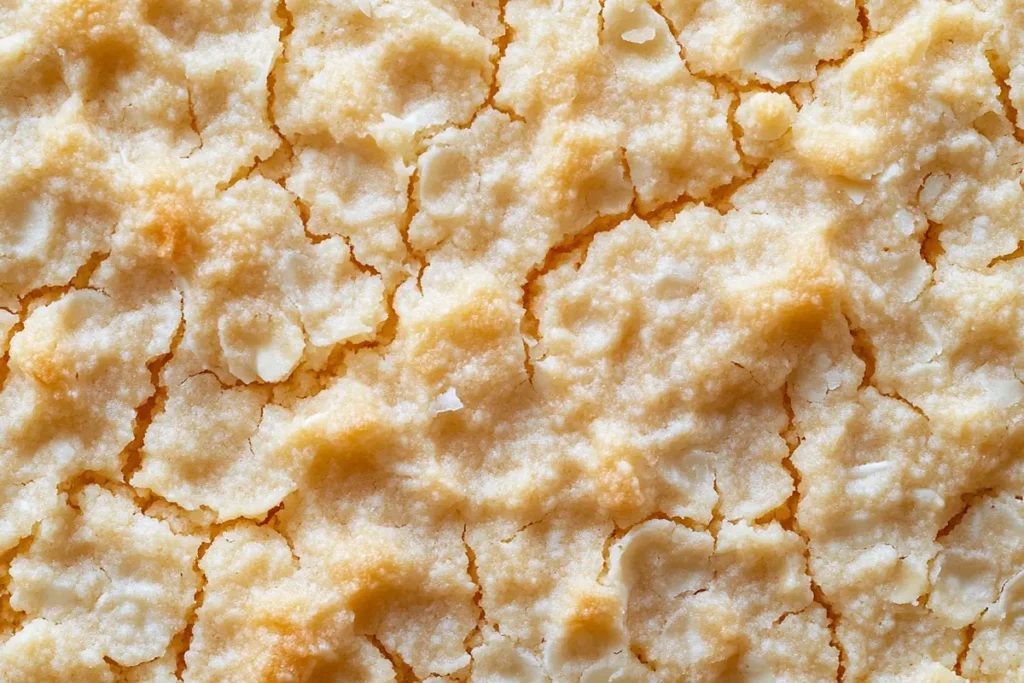
Texture Realities of No Baking Soda Oatmeal Cookies
What is the actual texture like when you make no baking soda oatmeal cookies? Texture is often paramount in cookie enjoyment. Understanding the textural realities will help you anticipate the results and decide if this variation suits your preference.
Denser and More Compact Crumb
The most consistent textural outcome is a denser crumb. No baking soda oatmeal cookies lack the airy pockets created by carbon dioxide gas. This results in a tighter, more compact internal structure. Imagine a cookie that feels significantly heavier for its size.
This density translates to a firmer bite. The cookies are less yielding and require more effort to chew through. The crumb is less delicate and more solid. This denser texture is a primary departure from typical oatmeal cookies.
Reduced Chewiness or Lack Thereof
Chewiness, a hallmark of many oatmeal cookies, is significantly diminished or entirely absent. The open crumb structure that promotes chewiness is simply not there without baking soda’s leavening action. Expect a cookie that is less pliable and more brittle.
Instead of a soft, chewy center, you might find a more crumbly or even slightly dry texture. The chewiness factor, often highly desired in oatmeal cookies, is one of the biggest losses when baking soda is omitted. This lack of chewiness alters the fundamental eating experience.
Firmer Overall Structure
The overall structure of no baking soda oatmeal cookies is firmer. They hold their shape well and are less prone to crumbling or breaking. This firmness stems from the denser crumb and reduced spread. They feel more solid in hand.
While firmness isn’t necessarily negative, it’s a departure from the often softer, more delicate structure of classic oatmeal cookies. The firmer structure can make them less melt-in-your-mouth and more substantial, almost biscuit-like in their robustness. This structural change is readily apparent.
Potential for Dryness (Depending on Recipe)
Depending on the specific recipe and baking time, no baking soda oatmeal cookies can tend towards dryness. The denser texture and reduced spread can sometimes lead to a drier overall mouthfeel, especially if overbaked. Moisture retention can be less efficient without the leavening action.
Careful attention to baking time is crucial to minimize potential dryness. Overbaking will exacerbate this issue. While not always guaranteed, dryness is a potential textural challenge to be aware of when baking without baking soda. Adjusting baking time downwards might be necessary.
Less Tender Bite
The bite of no baking soda oatmeal cookies is generally less tender. The firmer, denser structure contributes to a less yielding bite. They require more chewing and lack the soft, melt-in-your-mouth quality associated with tender cookies.
Tenderness is a highly valued textural attribute in cookies. Its reduction is a significant consequence of omitting baking soda. The less tender bite can make them feel less delicate and more rustic, which might be acceptable depending on personal preference but is a definite textural shift.
More Crumbly Edges (Sometimes)
While the interior is denser, the edges of no baking soda oatmeal cookies can sometimes be more crumbly. This might seem counterintuitive, but the lack of spread and altered gluten development can lead to edges that are less cohesive and more prone to crumbling when bitten into.
This crumbly edge texture is not always consistent but can occur. It adds another textural dimension that differs from the more defined edges of baking soda cookies. The combination of a dense interior and potentially crumbly edges creates a unique, albeit different, textural profile.
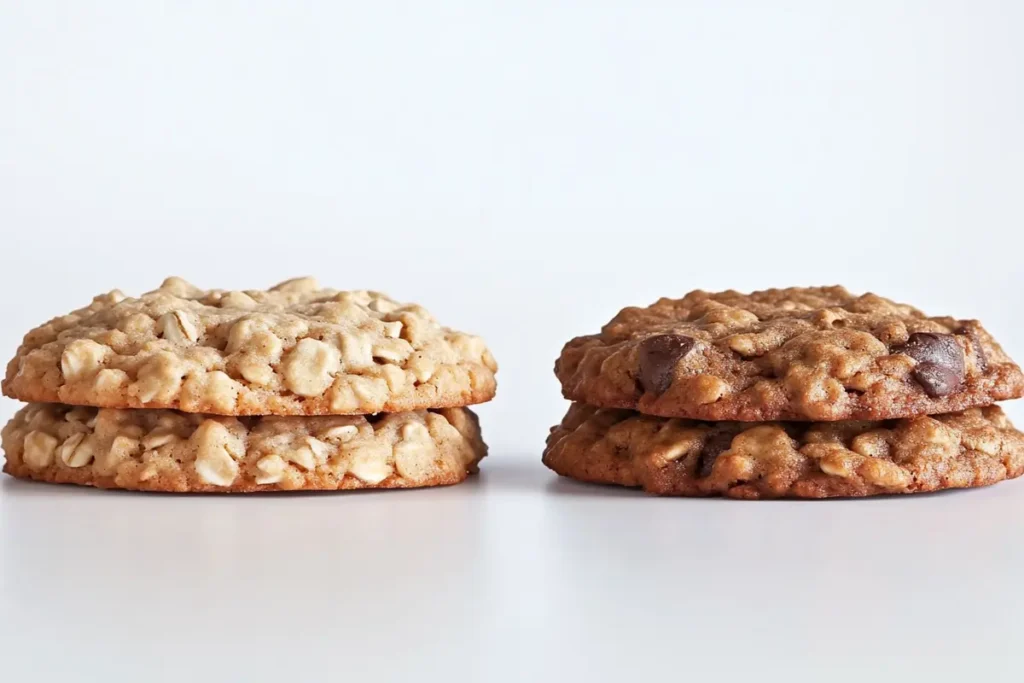
Taste and Appearance: What to Expect
Beyond texture, taste and appearance are also noticeably different in no baking soda oatmeal cookies. These sensory aspects contribute significantly to the overall enjoyment of cookies. Understanding these changes is important for setting expectations.
Paler Color and Reduced Browning
Visually, no baking soda oatmeal cookies are often paler. They lack the deep golden-brown color that baking soda promotes. The reduced Maillard reaction means less color development, resulting in a lighter, less caramelized appearance.
The paler color can make them look underbaked, even when fully cooked. Golden-brown color is a visual cue for doneness and flavor in baking. The lack of browning might make them seem less appealing visually to those accustomed to classic oatmeal cookies.
Subtler Flavor Profile (Less Depth)
The flavor profile tends to be subtler and less complex. Baking soda enhances flavor development and balance. Without it, the sweetness might be more dominant, and other flavors, such as spices or oats, might be less pronounced.
The overall flavor might be perceived as flatter or less nuanced. While still palatable, they lack the depth and complexity that baking soda contributes. The subtle flavor modifications are not always dramatic, but discerning tasters may notice the difference.
Less Defined Cookie Shape
Due to reduced spread, no baking soda oatmeal cookies have a less defined cookie shape. They tend to be more mounded and less flat. The edges are less crisp and less clearly defined. The overall shape is less characteristic of typical oatmeal cookies.
The shape becomes more rustic and less refined. If you are aiming for perfectly round, evenly spread cookies, omitting baking soda will make it harder to achieve that. The less defined shape is a visual departure from classic cookie aesthetics.
Potentially Sweeter Taste (Perception)
Because baking soda balances sweetness, no baking soda oatmeal cookies can sometimes taste perceptibly sweeter. The absence of the slight saltiness and flavor complexity that baking soda adds can make the sweetness more dominant on the palate.
This perceived increase in sweetness is not always dramatic but can be noticeable. If you prefer less sweet cookies, the no baking soda version might taste slightly unbalanced in terms of sweetness. The sweetness perception is a subtle but potential change.
Less Visually Appealing (Subjective)
Subjectively, many find no baking soda oatmeal cookies less visually appealing. The paler color, less defined shape, and thicker appearance can make them seem less like traditional, desirable oatmeal cookies. Visual appeal is important in food enjoyment.
While taste is paramount, visual presentation also plays a role in how we perceive food. The less classic appearance of no baking soda oatmeal cookies might make them seem less appetizing to some, even if the taste is still acceptable. Visual appeal is a subjective but relevant factor.
Aroma Differences (Subtle)
There might be subtle aroma differences. Baking soda contributes to the overall baking aroma. No baking soda oatmeal cookies might have a slightly less pronounced “baked cookie” aroma. However, this difference is often very subtle and less noticeable than texture and visual changes.
Aroma is a key component of the sensory experience of eating. While the aroma difference might be less dramatic, it is another subtle way in which no baking soda oatmeal cookies deviate from the expected sensory profile.
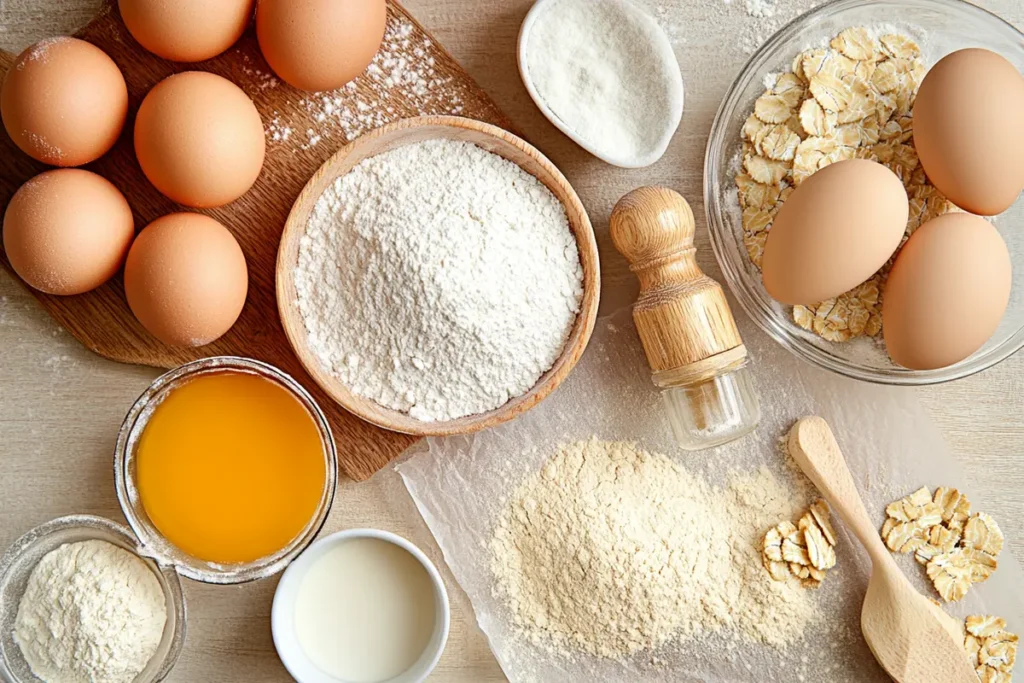
Making No Baking Soda Oatmeal Cookies Better
If you find yourself with no baking soda oatmeal cookies, or if you intentionally want to bake them this way for a different result, there are ways to make them better. These techniques focus on enhancing flavor and texture to compensate for the missing leavening agent.
Increase Spices for Flavor Boost
To compensate for the potentially flatter flavor profile, increase the amount of spices in your recipe. Add more cinnamon, nutmeg, or ginger. Consider adding other warm spices like cardamom or cloves. Boosting spices can add depth and complexity.
Experiment with spice combinations to find what you enjoy most. A bolder spice profile can make up for the subtle flavor nuances lost by omitting baking soda. Spice enhancement is a straightforward way to improve flavor.
Add Extracts for Flavor Depth
Incorporate extracts to add more flavor depth. Vanilla extract is a classic choice, but consider almond extract, maple extract, or even a touch of rum extract. Extracts can add concentrated flavor that compensates for the lack of baking soda’s flavor enhancement.
Use high-quality extracts for the best results. A combination of extracts can create a more complex and interesting flavor profile. Flavor extracts are a versatile tool for improving taste.
Incorporate Chocolate or Dried Fruit
Additions like chocolate chips, chopped nuts, or dried fruit can enhance both flavor and texture. Chocolate adds richness and sweetness. Nuts provide crunch and flavor. Dried fruit adds chewiness and sweetness. These additions can make the cookies more interesting and satisfying.
Choose high-quality chocolate and dried fruit for the best results. A combination of additions can create a more complex and enjoyable cookie. Inclusions are a great way to improve no baking soda cookies.
Toast Oats for Nutty Flavor
Toasting the oats before adding them to the dough can significantly enhance their nutty flavor. Spread the oats on a baking sheet and toast them in a low oven until lightly golden and fragrant. Toasted oats add a deeper, richer flavor that can elevate the cookies.
Allow the toasted oats to cool completely before incorporating them into the dough. Toasting is a simple step that makes a big difference in flavor depth. Toasted oats are a flavor-boosting technique.
Adjust Baking Time Carefully
Since no baking soda cookies spread less and can be denser, adjust baking time carefully. They might require slightly longer baking to cook through completely, but be cautious not to overbake and dry them out. Monitor them closely towards the end of baking.
Start checking for doneness a few minutes earlier than the recipe suggests. Look for lightly golden edges and a set center. Proper baking time is crucial to avoid dryness. Baking time adjustment is important for texture.
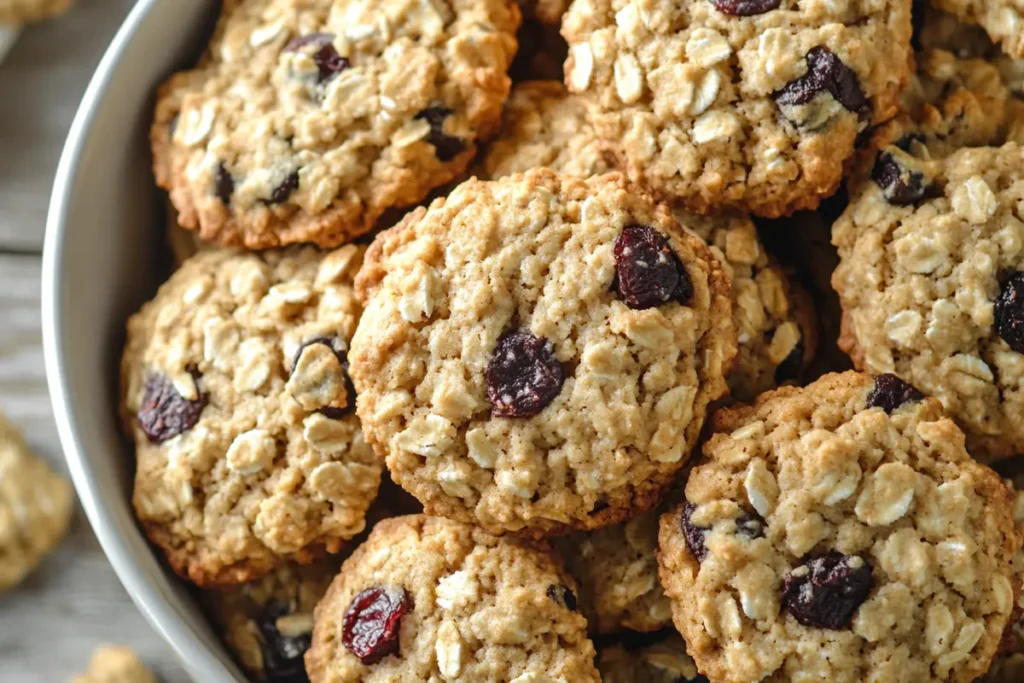
Are No Baking Soda Oatmeal Cookies Safe to Eat?
A common concern is food safety. Are no baking soda oatmeal cookies safe to eat? The answer is yes, omitting baking soda does not inherently make oatmeal cookies unsafe to eat. Food safety depends on other factors, not the presence or absence of baking soda.
Baking Soda is Not a Preservative
Baking soda is a leavening agent, not a preservative. It does not inhibit bacterial growth or prevent food spoilage. Its primary function is to create texture and rise in baked goods. Its presence or absence does not directly impact food safety.
Food safety relies on proper handling of ingredients, cooking to a safe internal temperature, and storing baked goods correctly. Baking soda plays no role in these aspects of food safety. Baking soda is not a food safety factor.
Food Safety Depends on Ingredients and Handling
The safety of oatmeal cookies, with or without baking soda, depends on the freshness and quality of ingredients. Using fresh eggs, butter, and oats is important. Proper hygiene during preparation is also essential. These factors are crucial for food safety.
Ensuring the cookies are baked to a safe internal temperature is also important, although cookies are typically baked at temperatures high enough to kill most bacteria. However, proper handling and fresh ingredients are the primary food safety considerations. Ingredient quality and handling are key to safety.
Storage is Key for All Baked Goods
Proper storage is crucial for all baked goods, including oatmeal cookies, regardless of baking soda content. Store cookies in airtight containers at room temperature for a few days, or freeze them for longer storage. Proper storage prevents spoilage and maintains quality.
Following recommended storage guidelines ensures food safety and extends shelf life. Storage practices are essential for all cookies. Proper storage is always necessary.
No Increased Risk Without Baking Soda
There is no increased risk of foodborne illness from eating no baking soda oatmeal cookies compared to those made with baking soda. As long as you use fresh ingredients, practice good hygiene, bake them properly, and store them correctly, they are perfectly safe to consume.
The absence of baking soda does not create any food safety hazards. Enjoy your no baking soda oatmeal cookies with confidence, knowing they are just as safe as their baking soda counterparts, provided standard food safety practices are followed. No baking soda does not increase risk.
FAQ
Are no baking soda oatmeal cookies safe to eat?
Yes, no baking soda oatmeal cookies are safe to eat. Baking soda is a leavening agent and not a preservative. Food safety depends on using fresh ingredients, proper handling, and correct storage, not the presence of baking soda.
What texture are no baking soda oatmeal cookies?
No baking soda oatmeal cookies are typically denser, firmer, and less chewy than traditional oatmeal cookies. They have a more compact crumb and spread less during baking, resulting in a thicker, less airy cookie.
How to make no baking soda oatmeal cookies better?
To improve no baking soda oatmeal cookies, enhance flavor by increasing spices or adding extracts. Incorporate chocolate chips, nuts, or dried fruit for taste and texture. Toast the oats for a nuttier flavor. Adjust baking time carefully to avoid dryness.
What are the benefits of baking soda in oatmeal cookies?
Baking soda in oatmeal cookies acts as a leavening agent, creating a softer, chewier texture. It promotes spread, leading to thinner cookies with crisp edges. Baking soda also enhances browning and contributes to a more complex flavor profile.
For More Delicious Recipes :
Dubai Chocolate Bar Recipe: A Decadent Taste of the Middle East
Cinnamon Toast Crunch Cookies Recipe: Your Next Favorite Treat

